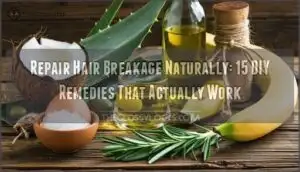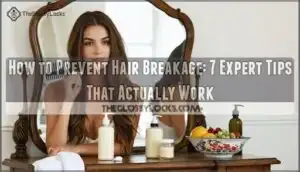This site is supported by our readers. We may earn a commission, at no cost to you, if you purchase through links.
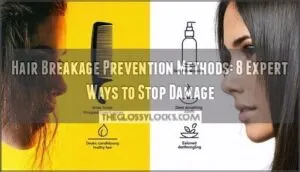 You can prevent hair breakage by limiting wash days to 2-3 times weekly, using lukewarm water instead of hot, and gently towel-drying with a microfiber cloth or t-shirt.
You can prevent hair breakage by limiting wash days to 2-3 times weekly, using lukewarm water instead of hot, and gently towel-drying with a microfiber cloth or t-shirt.
Don’t brush wet hair aggressively—detangle with a wide-tooth comb starting from ends. Minimize heat styling or use protective sprays when you do.
Sleep on silk pillowcases to reduce friction, and avoid tight ponytails that stress your strands.
Regular deep conditioning treatments restore moisture, while protein masks strengthen weakened hair. A balanced diet rich in biotin, iron, and omega-3s supports healthy growth from within.
These simple hair breakage prevention methods can transform fragile strands into resilient, healthy hair that grows longer and stronger.
Table Of Contents
- Key Takeaways
- What Causes Hair Breakage
- Identifying Hair Breakage
- Preventing Hair Breakage
- Top 8 Hair Breakage Prevention Products
- 1. Pantene Miracle Rescue Damaged Hair Treatment
- 2. amika Kure Strength Repair Treatment
- 3. Briogeo Rice Water Protein Treatment
- 4. It’s A 10 Keratin Conditioner
- 5. MONDAY HAIRCARE Moisture Shampoo 30oz
- 6. Dove Breakage Remedy Hair Conditioner
- 7. Moroccanoil Treatment Hair Oil 1.7oz
- 8. tgin Miracle RepaiRx Anti Breakage Serum
- Home Remedies for Hair Strengthening
- Reducing Breakage With Proper Hair Care
- Repairing and Restoring Damaged Hair
- Frequently Asked Questions (FAQs)
- How do you prevent hair breakage?
- What is a holistic approach to preventing hair breakage?
- How to repair hair breakage?
- Can hair care products prevent hair breakage?
- What are hair breakage treatments & products?
- What are the different types of hair breakage treatments?
- What is the biggest cause of hair breakage?
- Why is my hair so prone to breaking?
- Can hair breakage be completely reversed naturally?
- How long does hair breakage recovery take?
- Conclusion
Key Takeaways
- Limit washing to 2-3 times weekly using lukewarm water and gentle, microfiber towel-drying to preserve your hair’s natural moisture barrier and prevent brittleness.
- Minimize heat styling by keeping tools below 300°F, always using heat protectant sprays, and choosing air-drying or heatless styles whenever possible to maintain protein structure.
- Use gentle detangling techniques with wide-tooth combs on damp hair, starting from the ends and working upward, while avoiding aggressive brushing that can snap weakened strands.
- Nourish from within and without by eating protein-rich foods with biotin and omega-3s, applying weekly deep conditioning treatments, and sleeping on silk pillowcases to reduce friction damage.
What Causes Hair Breakage
Hair breakage happens when your strands become weak and snap along the shaft, creating shorter pieces throughout your hair.
Understanding the root causes helps you protect your hair before damage occurs.
Dryness and Lack of Hydration
Dehydration strikes your hair like a drought hits parched earth.
Weak strands snap under pressure like brittle autumn leaves in your hands.
When you’re not drinking enough water or your scalp’s oil production slows down, your strands lose their natural moisture barrier**.
This creates higher porosity levels, making hair vulnerable to breakage.
Humectant benefits from proper hydration for hair keep your locks supple and strong, preventing the brittleness that leads to snapping.
Excessive Heat Styling
Heat styling tools damage your hair’s protein structure through excessive temperatures, leading to weakened strands and increased breakage.
Hair dryers, curling irons, and straighteners strip moisture when used frequently without heat protectant spray.
Temperature control matters—reduce settings below 300°F for damaged hair, and tool quality affects heat distribution, while proper drying techniques minimize exposure time.
Limit styling frequency and always apply heat protectants before styling.
Chemical Treatments and Processes
Chemical treatments like dye, perms, and relaxers damage hair’s protein structure, making strands weak and brittle.
Keratin treatments create chemical overlap when combined with other processes, and hair processing breaks down protective cuticles, leaving hair vulnerable to breakage.
To maintain hair integrity, minimize chemical processing by spacing treatments months apart and choosing relaxer alternatives when possible, which helps prevent damage from chemical overlap and breakage, ultimately preserving the hair’s protein structure and ensuring hair integrity.
Improper Diet and Nutrition
Your body needs proper nutrition to build strong hair.
Strong hair starts with the nutrients you put in your body—feed your follicles well.
Nutrient deficiencies in protein, iron, vitamin D, and zinc weaken hair structure, making strands prone to breaking.
Poor protein intake disrupts keratin production, while mineral balance issues affect follicle health.
A healthy hair diet with adequate hydration importance and vitamin impact prevents breakage from nutritional gaps.
Because hair is considered non-essential tissue, its energy needs are often deprioritized by the body.
Identifying Hair Breakage
Before you can prevent hair breakage, you need to recognize the warning signs that damage is occurring.
Learning to distinguish between natural new growth and actual breakage will help you take action before the problem worsens, which is a key step in preventing further damage.
Short Uneven Strands
One of the clearest breakage indicators you’ll notice is short, uneven strands scattered throughout your hair.
These pieces are noticeably shorter than your normal strand length, creating an inconsistent appearance.
Unlike new growth, which appears uniformly at the hairline, breakage shows up randomly with varying lengths.
You’ll often spot these density differences when running your fingers through your hair, especially around areas prone to hairline breakage.
Addressing this may involve understanding causes of hair breakage, which is crucial for maintaining healthy and consistent hair appearance, and preventing further damage.
Split Ends and Frayed Hair
Split ends appear as tiny forks at your hair tips, while fraying shows up as rough, damaged sections along the shaft.
These telltale signs of hair breakage prevention needs occur when your hair’s protective cuticle weakens.
Identifying causes early helps with split end repair and hair strengthening.
Regular trimming frequency and hydration importance can’t be overstated for preventing splits and repairing fraying through consistent hair repair routines.
Hair Clustering and Density
When examining your hair’s overall appearance, look for density variation from roots to ends.
Healthy hair maintains consistent strand thickness throughout its length, while breakage creates uneven root density compared to mid-lengths and ends.
Notice hairline clusters of short hairs versus uniform growth patterns.
A simple strand test reveals dramatic differences in hair health and elasticity between sections.
Localized Breakage Areas
Breakage doesn’t strike randomly across your scalp—it targets specific vulnerable zones where stress concentrates.
Understanding these hotspots helps you identify problem areas before damage spreads throughout your hair.
Here are the most common localized breakage areas:
- Hairline Breakage – Occurs from tight ponytails, headbands, and frequent styling manipulation around your face
- Crown Breakage – Results from excessive brushing, heat styling, and chemical processing at your scalp’s highest point
- Nape Breakage – Develops from collar friction, rough towel drying, and tension from tight hairstyles at your neck’s base
Preventing Hair Breakage
You can prevent hair breakage by adopting gentle care routines and protecting your hair from damage-causing factors.
The key lies in understanding what weakens your hair strands and making simple changes to your daily habits.
Gentle Hair Care Routines
Transform your daily routine with hair breakage prevention methods that protect every strand.
Use wide-tooth combs for gentle detangling, starting from tips upward. Sleep on silk pillowcases to reduce friction overnight. Pat hair dry with soft towels instead of rubbing vigorously.
Choose protective styles like loose braids. These simple switches create a foundation for stronger, healthier hair.
For detangling, consider a comb designed for optimal hair care, which can be a key part of your daily routine.
Minimizing Heat Styling
Heat styling tools damage your hair’s protein structure, making breakage inevitable.
Lower your blow dryer, curling iron, and straightener temperatures to reduce damage. Always apply heat protectant spray before styling—it creates a barrier between tools and strands.
Many brands offer various spray options for different hair types.
Try air drying when possible, or explore heatless styles like braids and twists for gorgeous results without the risk.
Regular Trims and Maintenance
Regular trims every 6-8 weeks prevent split ends from traveling up your hair shaft, causing extensive breakage.
Professional haircuts remove damaged ends before they worsen, supporting healthy hair growth.
Consistent trimming maintains your hairstyle’s shape while eliminating weakness points.
This simple hair breakage prevention tip keeps your strands stronger and reduces the need for major cuts later, which is a key part of hair breakage prevention and helps in maintaining your hairstyle.
Balanced Diet and Nutrition
Your diet directly impacts hair strength since hair is 95% protein.
Without adequate protein intake from eggs, fish, and lean meats, your strands weaken and break easily.
Vitamin deficiencies in biotin, iron, and vitamin D compromise follicle health.
Proper mineral absorption supports keratin synthesis, while hydration importance can’t be overstated—dehydrated hair snaps.
Include healthy fats for moisture retention.
Addressing urgent protein needs can be determined by hair strand elasticity tests.
Top 8 Hair Breakage Prevention Products
You’ll find the right products can make all the difference in preventing hair breakage and keeping your strands strong.
These eight expert-recommended treatments target the root causes of damage while strengthening your hair’s natural protective barrier.
1. Pantene Miracle Rescue Damaged Hair Treatment

Pantene’s Miracle Rescue stands out as a budget-friendly powerhouse that delivers salon-quality results.
This intensive treatment uses Pro-Vitamin B5 and melting Pro-V pearls to rebuild broken hydrogen bonds in your hair’s core structure.
Clinical testing shows it repairs up to six months of damage in one use, matching $50 treatments at under $15.
The formula targets extreme damage while preventing future breakage, making your hair visibly stronger and shinier without weighing it down.
Best For: People with chemically treated, color-treated, or severely damaged hair who want professional-level repair results without the salon price tag.
- Repairs up to 6 months of damage in a single use with clinical results matching $50 treatments
- Lightweight formula strengthens and adds shine without weighing hair down
- Excellent value at under $15 with consistent 4.5 star user ratings
- Small 0.5oz packaging may be wasteful for users with longer or thicker hair
- Not suitable for daily use – recommended only every few days
- Can make shower surfaces slippery during application
2. amika Kure Strength Repair Treatment

If you’re searching for a fast fix, amika Kure Strength Repair Treatment might be your new go-to.
In just 60 seconds, this vegan, bond-fortifying formula targets weak spots, making hair up to 2.4 times stronger and reducing breakage by 58%.
It’s packed with quinoa proteins and sea buckthorn oil, so you get softness, shine, and resilience.
Use it 1–2 times weekly after shampooing, and you’ll notice smoother hair that’s easier to brush and style—no magic wand required.
Best For: People with damaged, frizzy, or breakage-prone hair who want quick strengthening results without spending extra time on lengthy treatments.
- Works in just 60 seconds with clinically proven results (2.4x stronger hair, 58% less breakage)
- Versatile formula can be used as either a rinse-out treatment or leave-in product
- Contains bond-fortifying technology with vegan proteins and nourishing plant oils for comprehensive repair
- Some users report dryness and hair damage with continued use, indicating it may not suit all hair types
- Results vary significantly between individuals, with mixed feedback on long-term hair health improvements
- Requires consistent use 1-2 times weekly to maintain benefits, making it an ongoing commitment rather than a one-time fix
3. Briogeo Rice Water Protein Treatment
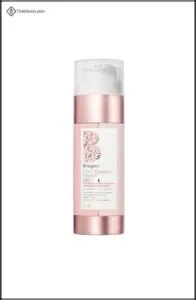
Briogeo’s Rice Water Protein Treatment strengthens your hair up to 2X while reducing breakage by 60% after just one use.
This dual-action formula combines rice protein complex with B vitamins and algae extract to fortify damaged cuticles and restore elasticity.
You’ll apply it to clean, damp hair for 10 minutes weekly, focusing on severely damaged areas.
The 98% naturally derived treatment works without sulfates, silicones, or parabens, making it suitable for all hair textures seeking intensive repair.
Best For: Severely damaged hair from heat styling, chemical processing, or bleaching that needs intensive strengthening and breakage prevention.
- Clinically proven to reduce breakage by 60% and strengthen hair up to 2X after one use
- Clean formula with 98% naturally derived ingredients, free from sulfates, silicones, and parabens
- Works on all hair textures with a lightweight consistency that penetrates deeply without weighing hair down
- Higher price point compared to DIY rice water treatments or drugstore alternatives
- May cause overstrengthening in protein-sensitive hair if used too frequently
- Some users report minimal immediate results, requiring consistent weekly use for noticeable improvement
4. It’s A 10 Keratin Conditioner

This premium leave-in conditioner delivers powerful keratin amino acids and hydrolyzed keratin to rebuild damaged hair structure from within.
You’ll notice increased elasticity and reduced breakage, especially if you have chemically treated or color-processed hair.
The formula includes aloe vera and sunflower seed extract that smooth cuticles while providing heat and UV protection.
Apply sparingly to towel-dried hair, focusing on mid-lengths to ends for best results, utilizing the leave-in conditioner.
Best For: People with damaged, chemically treated, or color-processed hair who need intensive keratin repair and breakage prevention.
- Contains keratin amino acids and hydrolyzed keratin that rebuild hair structure and reduce breakage
- Natural ingredients like aloe vera and sunflower seed extract provide heat and UV protection
- Small amount needed per use makes it cost-effective despite premium pricing
- Can cause heaviness or oiliness if overused, especially on fine or fragile hair
- Premium pricing may be prohibitive for some users
- Occasional shipping issues with leakage reported by some customers
5. MONDAY HAIRCARE Moisture Shampoo 30oz

When your hair’s constantly battling dryness and breakage, MONDAY HAIRCARE’s Moisture Shampoo delivers the hydration boost you need.
This award-winning formula combines coconut oil, shea butter, and vitamin E to strengthen hair while adding shine.
The sulfate-free, pH-balanced formula won’t strip your natural oils, making it perfect for color-treated hair.
At 30oz, you’ll get lasting value while the rice protein works to fortify each strand against future damage.
Best For: People with dry, frizzy, or color-treated hair who need deep hydration and strengthening without harsh sulfates.
- Some users report increased shedding and dryness, particularly those with thin or chemically-treated hair
- May not be effective for all hair types, with mixed results reported for low porosity hair
- Fast consumption rate noted by families sharing the product
- Award-winning sulfate-free formula with coconut oil, shea butter, and rice protein strengthens while adding moisture and shine
- Large 30oz size offers excellent value and reduces frequent repurchasing needs
- Safe for color-treated hair with pH-balanced, cruelty-free formulation that won’t strip natural oils
6. Dove Breakage Remedy Hair Conditioner

When damage threatens your hair’s integrity, Dove’s Breakage Remedy Conditioner delivers clinical-grade protection with its patented Nutrient-Lock serum technology.
This paraben-free formula penetrates deep into hair fibers, reducing breakage by up to 97% when used consistently as part of the three-step system.
You’ll notice stronger, thicker-looking strands after just weeks of use, thanks to dipeptides and conditioning actives that target damage at the cellular level.
Apply from mid-lengths to ends, leave for two minutes, then rinse for maximum strengthening benefits.
Best For: People with damaged, breakage-prone hair who want a drugstore conditioner that delivers salon-quality strengthening results.
- Requires use of the complete 3-step system (shampoo, conditioner, leave-on treatment) for maximum advertised results
- Some users report mild scent that may not appeal to everyone’s preferences
- Less concentrated formula compared to some premium salon brands, requiring more product per application
- Clinically proven to reduce hair breakage by up to 97% with consistent use of the 3-step system
- Contains advanced Nutrient-Lock serum with dipeptides that penetrate deep into hair fibers for cellular-level repair
- Paraben-free, cruelty-free formula suitable for daily use on all hair types without weighing hair down
7. Moroccanoil Treatment Hair Oil 1.7oz
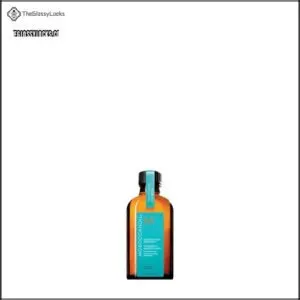
With antioxidant-rich argan oil at its core, Moroccanoil Treatment delivers exceptional results for breakage prevention.
You’ll notice up to 118% more shine while the lightweight formula penetrates your hair shaft to strengthen damaged strands.
Apply just 1-2 drops to damp hair, focusing on mid-lengths and ends.
This concentrated treatment reduces split ends, improves elasticity, and creates a protective barrier against environmental stress without weighing your hair down.
Best For: People with thick, coarse, or damaged hair who need intensive shine, frizz control, and breakage prevention without heavy buildup.
- Dramatically increases shine by up to 118% while strengthening hair and reducing split ends
- Highly concentrated formula means just 1-2 drops provide long-lasting results, making it cost-effective despite higher price
- Lightweight texture absorbs quickly without greasy residue, suitable for daily use on all hair types
- May be too heavy for fine or medium hair types, potentially weighing hair down
- Higher price point compared to other hair oils and treatments on the market
- Some users find the Mediterranean-inspired fragrance overpowering or too strong
8. tgin Miracle RepaiRx Anti Breakage Serum

When you’re battling brittle strands, tgin’s Miracle RepaiRx Anti Breakage Serum acts like a protective shield for your hair.
This lightweight formula combines castor, coconut, olive, argan, jojoba, and peach kernel oils with vitamin E to strengthen weakened hair shafts.
You’ll notice reduced frizz and improved manageability with regular use.
Apply a dime-sized amount daily or use it as a hot oil treatment for deeper repair.
Best For: People with dry, curly, or damaged hair seeking a lightweight, natural oil blend to reduce breakage and improve manageability.
- Contains six nourishing oils (castor, coconut, olive, argan, jojoba, peach kernel) plus vitamin E for comprehensive hair strengthening
- Versatile application options – works as daily protection, hot oil treatment, or overnight hydration boost
- Clean formula free from sulfates, parabens, petrolatum, and artificial colors with cruelty-free certification
- Mixed reviews on immediate results, with some users noting no significant difference initially
- Scent may be overwhelming for sensitive users, potentially limiting application amount
- Some reports of ingredient changes affecting product performance compared to earlier formulations
Home Remedies for Hair Strengthening
Kitchen ingredients offer powerful solutions for strengthening weak, breakage-prone hair without expensive salon treatments.
You can create effective hair masks using coconut oil, bananas, eggs, and essential oils that nourish your strands from root to tip.
Coconut Oil Scalp Massage
When you’re dealing with stubborn breakage, coconut oil becomes your hair’s best ally through targeted scalp stimulation. This time-tested remedy delivers essential moisture retention while strengthening hair follicles at their source.
Here’s how to maximize coconut benefits:
- Warm the oil slightly for better absorption
- Massage in circular motions for 5-10 minutes
- Focus on areas prone to breakage
- Leave on overnight for deep conditioning
Regular massage frequency of 2-3 times weekly promotes ideal oil absorption and supports long-term hair health.
Banana Hair Mask
Beyond coconut oil’s nourishing properties, bananas offer remarkable hair strengthening benefits.
This potassium-rich fruit contains proteins and natural fats that penetrate damaged hair shafts, making it an excellent DIY recipe for hair breakage prevention methods.
Mash one ripe banana with honey, apply this hair mask from roots to tips, then rinse after twenty minutes.
Bananas contain silica, which helps to combat hair frizz, resulting in stronger strands and reduced breakage within weeks of consistent application.
Egg Mask and Protein Treatment
Protein’s power transforms weak strands into resilient hair.
You’ll create an effective egg mask by whisking one whole egg with a tablespoon of olive oil. Apply this DIY egg mask to damp hair, focusing on mid-lengths and ends where breakage typically occurs.
Leave for twenty minutes before rinsing with cool water. This protein treatment strengthens hair cuticles and reduces future damage when used weekly, making it an effective way to achieve resilient hair through a simple DIY egg mask.
Essential Oils for Hair Growth
Essential oils offer a natural approach to strengthening hair and preventing breakage through improved circulation and follicle health.
These concentrated plant extracts work by stimulating blood flow to your scalp, promoting cellular regeneration, and providing antimicrobial protection that creates ideal conditions for healthy hair growth.
Here are three effective application methods:
- Oil Blends: Mix 25 drops of rosemary or lavender oil with 50ml carrier oils like jojoba
- Scalp Stimulation: Massage peppermint oil (2 drops diluted) for 5 minutes before washing
- Weekly Treatments: Apply essential oils twice weekly, leaving on scalp for 10+ minutes
Reducing Breakage With Proper Hair Care
Your daily hair care routine can either be your hair’s best friend or its worst enemy.
The right techniques protect your strands from unnecessary stress and damage while maintaining their natural strength and shine.
Choosing The Right Hairbrush
Your hairbrush choice substantially impacts breakage prevention. Natural boar bristles distribute oils and work best for fine hair, while flexible nylon bristles suit thick textures. Avoid stiff synthetic materials that damage wet hair.
A quality brush can often be found by browsing online retailers.
| Hair Texture | Best Brush Material |
|---|---|
| Fine Hair | Natural boar bristles |
| Thick/Coarse Hair | Flexible nylon or mixed |
| Curly Hair | Wide-tooth combs |
Replace brushes every 6-12 months for ideal scalp health and detangling effectiveness.
Gentle Towel Drying Techniques
Your hair’s worst enemy isn’t just rough brushing—it’s aggressive towel drying.
Traditional terry cloth towels create friction that damages your hair cuticles, leading to breakage and frizz. Microfiber towels offer a gentler alternative that protects your strands.
Here’s how to master gentle hair drying:
- Blot, don’t rub – Press the towel against wet hair instead of scrubbing vigorously
- Choose microfiber towels – Their smooth fibers reduce friction compared to cotton terry cloth
- Squeeze moisture gently – Work from roots to ends with light pressure
- Consider air-dry benefits – Let hair partially dry naturally before styling
- Check your towel material – Avoid rough textures that catch and pull strands
The right towel material makes all the difference in hair breakage prevention methods.
Avoiding Tight Hairstyles and Heat
Tight ponytails and high-heat styling tools create a recipe for disaster in terms of hair breakage prevention methods.
You’ll want to avoid tight hairstyles like severe buns or braids that pull at your roots, causing traction damage.
Instead, opt for protective hairstyles with gentle accessories like fabric-covered elastics.
When heat styling becomes necessary, use heat protectants and low-heat styling settings.
Air drying remains your hair’s best friend for preventing unnecessary stress and breakage.
Protecting Hair From Sun Damage
Beyond avoiding tight styles and heat, shielding your hair from UV rays prevents significant damage.
Sun exposure weakens hair proteins and fades color, making strands brittle and prone to breakage.
UV protection sprays create a barrier against harmful rays, while protective hairstyles like loose braids or buns minimize exposure.
Proper hydration importance can’t be overstated—moisturized hair resists UV damage better than dry strands.
Repairing and Restoring Damaged Hair
When your hair is already damaged, you’ll need targeted repair strategies to restore its strength and liveliness.
Deep conditioning treatments, regular trims, and professional guidance can help reverse existing damage and prevent further breakage.
Deep Conditioning Treatments
When conventional conditioners fall short, you’ll need intensive moisture therapy. Deep conditioning treatments work like overnight restoration, penetrating damaged cuticles with concentrated nutrients.
Apply treatments to damp hair using sectioning techniques for even coverage. Steam enhances absorption by opening hair shafts.
Balance protein-rich formulas with hydrating masks to prevent brittleness. Weekly deep conditioning is essential for restoring hair, and can be found at Weekly deep conditioning.
DIY conditioners using oils provide natural conditioning benefits for hair breakage prevention tips.
Trimming and Maintaining Hair Health
Regular maintenance through trimming regularly prevents hair breakage by eliminating split ends before they travel up the shaft.
Schedule healthy haircuts every 6-8 weeks for maximum trim frequency.
Sharp, clean scissors guarantee precise cuts that won’t fray hair cuticles.
Professional consultation helps determine ideal trimming schedules based on your hair type and damage level.
Consulting a Healthcare Provider for Severe Breakage
Sometimes your hair’s SOS signals mean it’s time to call in professional backup.
When hair breakage persists despite your best efforts, underlying conditions like thyroid problems, nutrient deficiencies, or hormonal imbalance might be the real culprits.
Your healthcare provider can identify scalp issues, review medications, and address medical conditions causing stubborn hair loss through proper testing and treatment.
They can help determine if there are any underlying medical conditions that need to be addressed.
Frequently Asked Questions (FAQs)
How do you prevent hair breakage?
Use microfiber towels, minimize heat styling, limit chemicals, apply deep conditioning masks, use heat protectant, wash less frequently, get regular trims, and sleep on silk pillowcases.
What is a holistic approach to preventing hair breakage?
A holistic approach combines gentle hair care practices, proper nutrition, stress management, and protective styling.
You’ll need adequate hydration, regular trims, minimal heat styling, silk pillowcases, and nutrient-rich foods to strengthen hair from inside out, with proper nutrition being key.
How to repair hair breakage?
Like a broken bridge needing careful reconstruction, you’ll repair damaged hair through targeted treatments.
Deep condition weekly, trim split ends regularly, use protein masks, apply heat protectant, and minimize chemical processing to rebuild strength.
Can hair care products prevent hair breakage?
Yes, you can prevent hair breakage with the right products.
Look for moisturizing shampoos, deep conditioners, heat protectants, and gentle formulas.
Avoid high-pH shampoos and harsh chemicals that strip natural oils and weaken hair structure, using gentle formulas instead is key.
What are hair breakage treatments & products?
Like damaged rope fibers, your hair needs targeted repair. You’ll find treatments including deep conditioning masks, protein treatments, leave-in conditioners, and bond-building serums that strengthen weakened strands and restore elasticity.
What are the different types of hair breakage treatments?
Hair breakage treatments include deep conditioning masks, protein treatments, oil therapies, leave-in conditioners, and professional salon procedures. You’ll also find strengthening shampoos and serums designed specifically for damaged hair repair.
What is the biggest cause of hair breakage?
Excessive heat styling from blow dryers, flat irons, and curling tools damages your hair’s protein structure, making it the top cause of breakage you’ll encounter.
Why is my hair so prone to breaking?
Your hair breaks easily due to several factors working against you.
Dryness from over-washing strips natural oils, heat styling damages the hair shaft, and chemical treatments weaken your hair’s structure over time.
Can hair breakage be completely reversed naturally?
Studies show only 30% of damaged hair can regenerate completely naturally.
You can’t fully reverse existing breakage, but you’ll prevent new damage and strengthen remaining hair using deep conditioning treatments, protein masks, and gentle care techniques to achieve complete regeneration is not possible, however, prevention and strengthening are viable options.
How long does hair breakage recovery take?
Recovery time depends on your hair’s growth rate and damage severity.
Expect 3-6 months to see significant improvement with consistent care, though complete recovery may take 6-12 months as damaged hair grows out.
Conclusion
Breaking free from brittle, damaged strands isn’t impossible—you just need the right approach.
These hair breakage prevention methods work when applied consistently. Gentle washing, protective styling, and proper nutrition create stronger hair over time.
Deep conditioning treatments and regular trims maintain healthy length. Heat protection prevents future damage while silk pillowcases reduce overnight friction.
Your commitment to these evidence-based techniques determines success in achieving resilient, breakage-resistant hair.
- https://www.livingproof.com/blogs/hair-101/how-to-strengthen-hair
- https://www.lorealparisusa.com/beauty-magazine/hair-care/damaged-hair/ways-to-prevent-hair-breakage
- https://www.reddit.com/r/HaircareScience/comments/zi3pdd/how_to_prevent_breakageweak_hair/
- https://www.healthline.com/health/how-to-strengthen-hair
- https://www.webmd.com/beauty/what-to-know-about-hair-breakage












